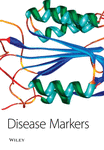Human Neutrophil Peptides 1–3 as Gastric Cancer Tissue Markers Measured by MALDI-Imaging Mass Spectrometry: Implications for Infiltrated Neutrophils as a Tumor Target
Abstract
Objective: Human neutrophil peptides (HNPs) -1, -2 and -3 are significantly upregulated and were reported as biomarkers in gastric cancer (GC). However, the tissue location and function of HNPs 1-3 are still unclear in GC, and the spatial distribution of the triad needs to be disclosed. The aims of this study were to investigate the distribution and relationships among HNPs-1, -2 and -3, and assess whether infiltrated neutrophils accumulate in gastric tumor.
Methods: In this study, paired samples (n=33) of the GC tissues and adjacent normal tissues from the same patients were obtained from surgery. Expression of HNPs 1-3 were detected by matrix-assisted laser desorption ionization time-of-flight mass spectrometry (MALDI-TOF MS). The distributions of the HNPs 1-3 in GC tissues were investigated. After verification of HNPs-1 by immunohistochemistry, infiltrated neutrophils were also detected. Then, an in vitro assay was used to observe the binding capacity and measure the cytotoxic effect of HNPs-1 against AGS cells.
Results: Comparing to neighboring normal tissue, expressional level of HNPs 1-3 were significantly higher and their distributions overlapped in cancerous tissues of GC patients with high abundance in the lamina propria, whereas HNPs-1 was identified as the highest major peak. Moreover, HNPs-1, -2 and -3 correlated with each other. Besides, we also observed that increased infiltrated neutrophils accumulating in GC tissues, indicating that a strong positive correlation between HNPs 1-3 and infiltrated neutrophils. In addition, the further investigated demonstrated that the major peptide, HNPs-1, was statistically increased with the advance of tumor development from the early to advanced stage of GC (p < 0.05). Moreover, we also noticed that HNPs-1 with a great binding capacity to GC AGS cells in vitro can inhibit tumor cell growth.
Conclusions: Our results suggest that neutrophil secreted peptides, HNPs 1-3, increased in the GC tissues and could be used as potential biomarkers detected using MALDI-TOF MS, implying that elevated neutrophils may be used as a tumor target for tumor treatment. The binding capacity of HNPs-1 with GC cells implies that tracking molecules conjugated with HNPs-1 could be applied as a specific probe for GC diagnoses.




